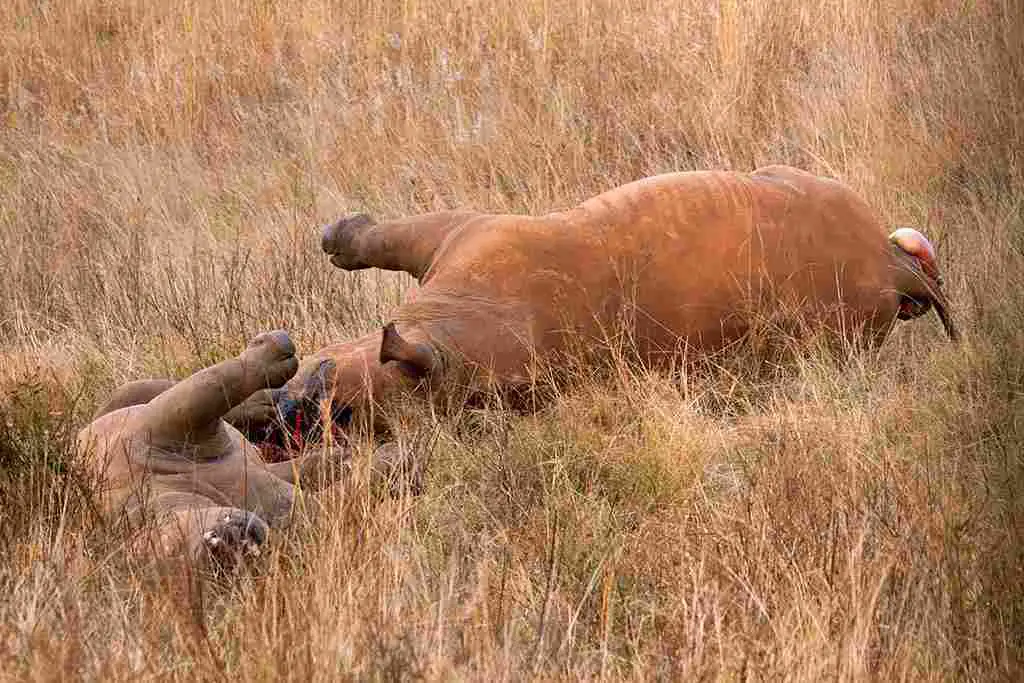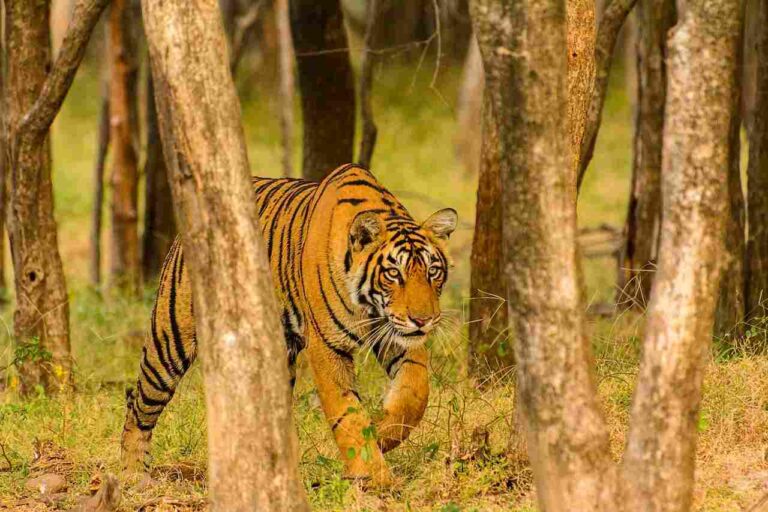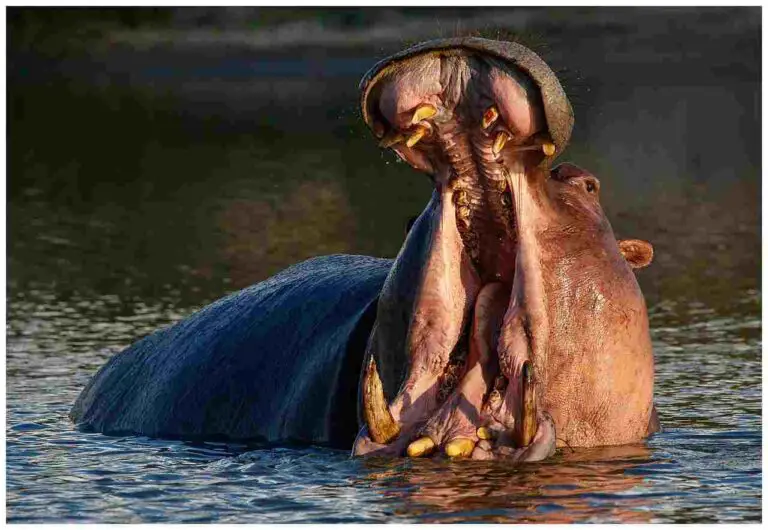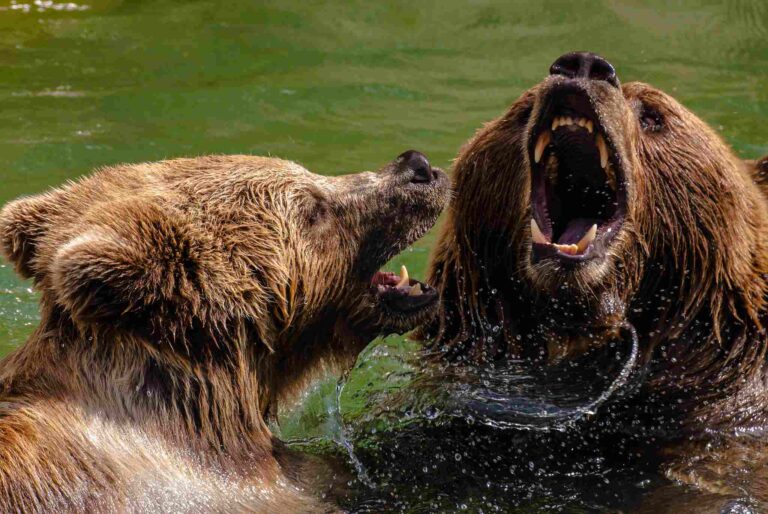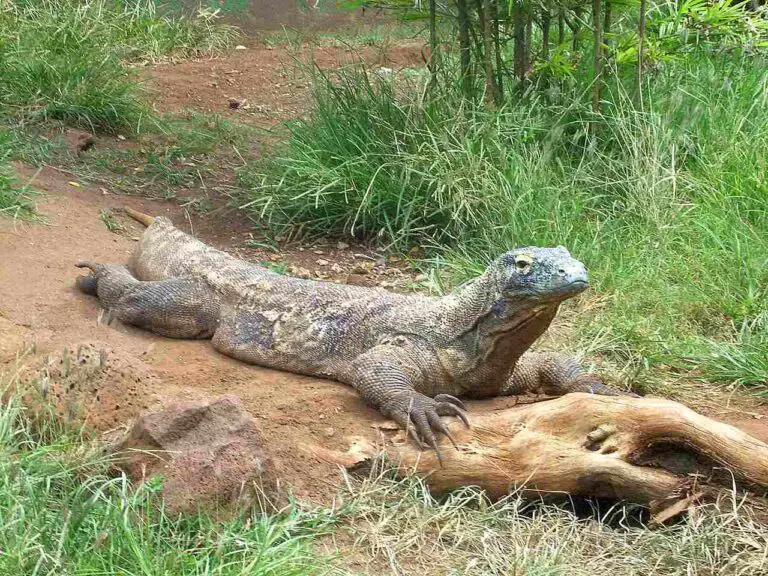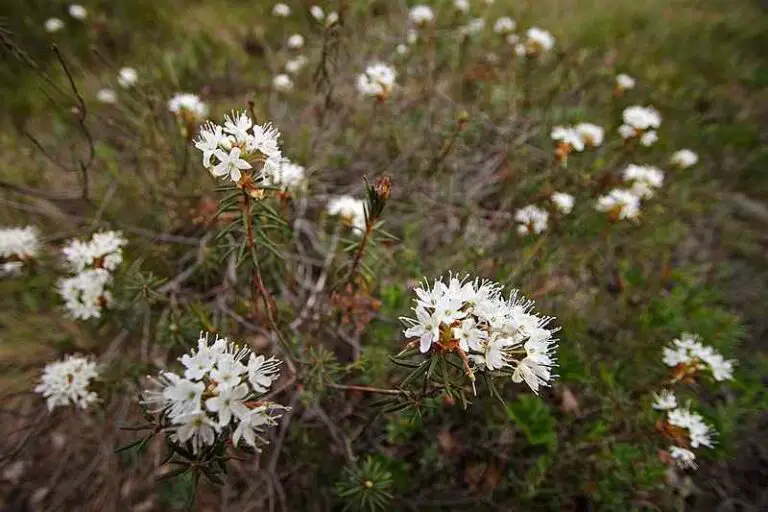7 Threats to the Savanna Biome Discussed
Threats to the savanna biome include; drought, overgrazing, introduction of invasive species; urbanization, poaching, land conversion for agriculture, and climate change.
This article discusses threats to the savanna biome, as follows;
-Natural Threats to the Savanna Biome
Natural threats to the savanna biome are; drought and overgrazing by native herbivores.
1). Drought: One of the Threats to the Savanna Biome
Drought is a significant threat to the savanna biome, which is typically characterized by a combination of grasslands and scattered trees, shrubs, and sparse woodland.
As a natural hazard, drought can have profound effects on this ecosystem, disrupting its delicate balance and resulting in various ecological consequences.
Effects of Drought on the Savanna Ecosystem
Effects of drought on the savanna ecosystem include reduced vegetation, changes in plant composition, decreased tree presence, wildlife displacement, altered grazing patterns, increased fire risk, threats to indigenous communities, soil erosion and extensive environmental degradation.
Drought conditions often result in limited water availability, which in turn reduces the rates of photosynthesis and plant growth respectively. These impacts can lead to a decline in overall vegetation productivity in the savanna.
Prolonged and severe dryness can cause shifts in the composition of savanna vegetation. Drought-resistant plant species may become more dominant, while the abundance of drought-sensitive species will progressively decline. This can alter the structure and dynamics of the ecosystem, and can have measurable implications for the savanna food chain.
Trees in the savanna biome are particularly vulnerable to drought, because their deeper root systems often compete with grasses for water. Drought can lead to stunted tree growth, or tree mortality, altering the balance between grasses and trees in the ecosystem.
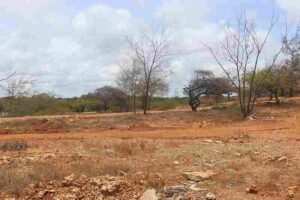
As stated earlier, drought can lead to the scarcity of available water and food resources within the savanna. As a result, native wildlife may be forced to migrate in search of suitable habitats, causing shifts in their species richness and distribution, and potentially leading to conflicts with human populations.
By altering plant growth and composition, drought can disrupt grazing patterns of herbivores in the savanna. As grasses become less abundant due to reduced rainfall, herbivores may intensify their impact on the remaining vegetation, which is equivalent to overgrazing and further stresses the ecosystem.
Dry conditions during drought increase the risk of wildfires. Savannas are fire-adapted ecosystems, but more frequent and intense fires can alter the vegetation composition, resilience and sustainability of the ecosystem, and threaten both plant and animal species.
Drought can also affect indigenous communities that rely on the savanna in various ways for their livelihoods. Reduced water and food resources can lead to hardships, food insecurity, and potential conflicts over resources.
Also, drought can exacerbate soil erosion in the savanna due to the loss of vegetation cover and the reduced ability of the soil to absorb and retain water. These effects make the soil more vulnerable to the devastating impacts of agents of erosion.
Additional Notes and Reiterations on Drought in the Savanna Ecosystem
If a drought occurs in the savanna, the ecosystem would face a range of challenges and consequences, which include;
Reduced vegetation productivity, leading to diminished food resources for herbivores.
Changes in the composition of plant species, potentially favoring drought-resistant species.
Increased competition between grasses and trees for limited water resources.
Wildlife displacement and migration in search of water and food.
Altered grazing patterns, with potential overgrazing in certain areas.
Increased risk of wildfires, impacting both plants and animals.
Threats to indigenous communities relying on the savanna for resources.
Soil erosion and degradation due to the loss of vegetation cover and reduced soil moisture.
Savannas are dynamic ecosystems which are adapted to seasonal variability, but prolonged and severe drought can challenge their resilience and have largescale ecological, social, and economic consequences.
Effective efforts at ecosystem management and conservation are needed to mitigate the effects of drought and protect the savanna biome.
2). Overgrazing
Overgrazing is another notable threat to the savanna biome, as it tends to impact both biotic and abiotic factors in the savanna.
The excessive grazing of livestock, including native ungulates like wildebeests, can have profound effects on this ecosystem, disrupting its ecological balance and facilitating the occurrence of various detrimental consequences. Some of these consequences are highlighted here.
Effects of Overgrazing on the Savanna Ecosystem
Effects of overgrazing on the savanna ecosystem include; loss of vegetation cover, land degradation, altered plant composition, reduced plant productivity, wildlife distribution changes, increased vulnerability to drought, loss of biodiversity, erosion and desertification.
Overgrazing involves the excessive consumption of grasses and other edible vegetation by herbivores, resulting in the removal of essential plant cover. This leaves the soil exposed and vulnerable to erosion and various kinds of mass wasting.
Trampling and intense grazing compact the soil, reducing its ability to absorb and retain water. This can result in increased soil erosion, decreased fertility, leaching and rapid desertification in arid and semi-arid savannas.
Overgrazing can favor the growth of certain plant species that are less palatable to herbivores, thereby facilitating shifts in the composition of the plant community. This can reduce the availability of food for wildlife.
In the same vein, overgrazing can lead to a decline in the productivity of savanna vegetation, impacting both the quantity and quality of forage available for herbivores.
Based on these effects, overgrazing can cause wildlife species to migrate in search of more productive habitats and food resources. This can disrupt the geographic distribution of savanna animals and place them at risk of extermination.
Overgrazed areas may be less resilient to drought conditions due to reduced vegetation cover and poor soil moisture retention. This can further stress the ecosystem and intensify degradation during periods of water scarcity.
As earlier implied, overgrazing can lead to the decline of plant species that are important for sustaining various animal species. This can in turn result in reduced biodiversity within the savanna biome as a whole.
In arid landscapes, prolonged overgrazing can contribute to desertification, transforming fertile land into unproductive desert areas. It exacerbates the process and severity of land degradation.
-Anthropogenic Threats to the Savanna Biome
Anthropogenic threats to the savanna biome include the introduction of invasive species, urbanization, poaching, land conversion for agriculture, and climate change.
3). Introduction of Invasive Species: One of the Threats to the Savanna Biome
The introduction of invasive species to the savanna biome is a notable threat that can disrupt the natural equilibrium and integrity of this ecosystem.
Invasive species can be described as non-native organisms that have been introduced outside their natural range, and (in many cases) have the potential to outcompete or harm native species. Their presence and proliferation in the savanna can have a range of adverse effects, some of which are highlighted in the following subsection;
Effects of Invasive Species on the Savanna Ecosystem
Effects of invasive species on the savanna ecosystem include; competition with native species, changes in ecosystem structure; altered fire regimes, habitat modification, predatory dynamics, spread of diseases, altered nutrient cycling, economic and agricultural impacts, as well as human health risks.
It is not uncommon for invasive species to outcompete native plants and animals for essential resources such as water, nutrients, food and sunlight. Through such unfavorable competition, they can displace or reduce the populations of native species, altering the composition of the ecosystem.
The introduction of invasive plants can lead to continuous changes in vegetation structure and composition. For example, the proliferation of invasive grasses may replace native species, affecting the availability of forage for herbivores.
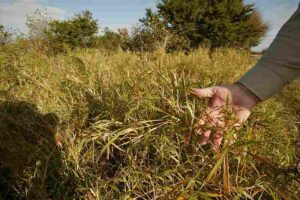
Some invasive plants, such as those with highly flammable characteristics, can increase the frequency and severity of wildfires within the savanna. Altered fire regimes can in turn have cascading effects on the vegetation and wildlife.
Invasive species can modify savanna habitats in ways that make them less suitable for native wildlife. This can disrupt nesting sites, supply of food sources, and other critical elements of the ecosystem.
Predatory invasive species can negatively impact native organisms in the grassland. For example, invasive predators can prey on or compete with native predators, potentially leading to declines in native populations, with altered food webs and energy transfer dynamics.
Some invasive species can act as vectors that introduce and spread diseases to native wildlife. This can result in increased mortality and population declines in susceptible organic groups.
Invasive plants may have different nutrient consumption and cycling patterns than native vegetation. Their presence can influence the availability of nutrients in the soil, affecting other plant species and ecosystem processes.
Economic threats can by posed by invasive species, by reducing agricultural productivity and requiring costly management measures.
Lastly, some invasive species can pose risks to human health, such as invasive plant species that cause allergies or invasive animals that spread zoonotic diseases to adjacent rural and urban areas.
Additional Notes and Reiterations on Invasive Species in the Savanna
When invasive species are introduced to the savanna biome, the ecosystem may experience a range of negative consequences, which include;
1. Competitive displacement of native species by invasive plants and animals.
2. Alterations in the composition and structure of the ecosystem.
3. Changes in fire regimes and increased wildfire risk.
4. Modification of habitats and nesting sites for native wildlife.
5. Increased predation and predatory competition by invasive species.
6. Spread of diseases to native wildlife.
7. Altered nutrient cycling and ecosystem dynamics.
8. Economic and agricultural impacts.
9. Potential health risks to humans.
Invasive species represent a major threat to the savanna biome, and their effective management and control are very important in the bid to preserve this unique ecosystem and its resources.
Efforts to prevent the introduction of invasive species and manage existing populations are critical for the conservation of the savanna.
4). Urbanization
Urbanization, which can be defined as the process of population growth and expansion of cities and towns, poses a notable threat to the savanna biome.
As human settlements and infrastructure encroach upon savanna ecosystems, the natural composition and resilience of these unique landscapes are increasingly at risk.
Urbanization affects the savanna in various ways, with significant consequences for both the environment and local communities. Some of these consequences are highlighted below;
Effects of Urbanization on the Savanna Ecosystem
Effects of urbanization on the savanna ecosystem include; habitat fragmentation, land conversion, altered water flow, pollution, introduction of invasive species, increased human-wildlife conflict, climate change implications, as well as various economic and social impacts.
The expansion of urban areas often leads to the fragmentation of savanna habitats. This can result in isolated patches of natural vegetation, making it difficult for wildlife to access essential resources, find mates, or seasonally migrate.
Conversion of savanna land for urban development, agriculture, and various forms of industrialism leads to the loss of natural vegetation. This not only reduces the available habitat for native species but also disrupts the balance of resources within the ecosystem.
Urbanization often involves the construction of roads, expansive and/or numerous buildings, and drainage systems. These alterations can change the natural flow of water in the savanna, affecting adjacent wetland ecosystems, seasonal flooding, and various hydrological processes that determine the availability of water for wildlife.
Urban areas commonly generate pollution from industrial (including agricultural) and residential activities. Pollutants such as industrial chemicals, heavy metals, and agricultural fertilizer can contaminate soil and water, negatively impacting the physicochemical conditions of the savanna ecosystem.
Also, urban areas can serve as hubs for the introduction and spread of invasive species. These non-native organisms can be introduced as agricultural plants/livestock, ornamental species, or even pests, and can infiltrate the savanna region, where they compete with native species and alter the composition of the ecosystem.
As urban areas expand, human-wildlife conflicts often arise. Native wildlife may venture into urban settings in search of food or refuge, leading to conflicts with residents and potential harm to the animals.
Factor such as urban heat islands, increased energy consumption, and altered land use patterns, can contribute to local climate changes that can affect the savanna ecosystem, altering its temperature patterns and rainfall.
Pressure can be exerted through urbanization, on savanna resources, including water, land, and wood for fuel, affecting the survival of native organisms. The growth of urban areas can lead to the loss of culturally important sites within the savanna, affecting the traditions and identity of indigenous communities.
Additional Notes and Reiterations on Urbanization in the Savanna
When urbanization occurs in the savanna biome, the ecosystem experiences various negative consequences, including;
1. Habitat fragmentation and reduced connectivity for wildlife.
2. Land conversion and loss of natural vegetation.
3. Changes in water flow and flooding patterns.
4. Pollution of soil and water resources.
5. Introduction and spread of invasive species.
6. Increased human-wildlife conflicts.
7. Local climate changes with potential ecological impacts.
8. Economic and social pressure on savanna resources.
9. Loss of cultural and heritage sites.
Urbanization poses a significant ecological threat to the savanna biome, and the development of sustainable urban planning and conservation strategies is important to mitigate its negative effects and ensure the continuity of these grassland ecosystems.
5). Poaching: One of the Threats to the Savanna Biome
Poaching is itself a severe threat to the savanna biome, particularly in Africa, where it impacts the rich diversity of wildlife that inhabits these unique landscapes.
Poaching refers to the illegal hunting or capturing of wild animals, and is usually driven by the economic prospects associated with wildlife trade. Effects of poaching on the savanna ecosystem are extensive and detrimental, with consequences for both the environment and adjacent local communities.
Effects of Poaching on the Savanna Ecosystem
Effects of poaching on the savanna ecosystem include; decline in wildlife populations, altered demography and behavior, ecological imbalance, economic and security impacts, loss of cultural and ecotourism value, and habitat modification.
Poaching involves the unsustainable harvest of wildlife, and leads to significant declines in population numbers. Iconic species such as elephants, rhinoceroses, and some large predators are particularly vulnerable.
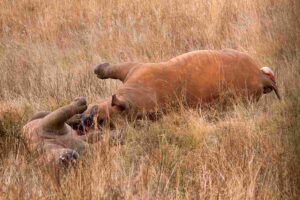
Poaching can affect the demography, behavior, and reproductivity of wildlife. For example, in the case of African elephants, it can lead to changes in population structure, breeding systems, and activity patterns.
The removal of keystone species, such as rhinoceroses, can disrupt the ecological balance of the savanna. These animals are essential to the ecosystem due to their roles in seed dispersal, plant regeneration, and landscape modification.
Poaching has economic implications, as the illegal trade in wildlife products, such as ivory from tusks, generates significant profits on the black market. The funds sometimes support other illegal ventures and organized crime.
The presence of iconic wildlife species in the savanna holds sociocultural and ecotourism significance. Poaching threatens the cultural heritage of indigenous communities within these regions, and reduces the appeal of wildlife tourism.
Efforts to combat poaching, such as increased patrols and fencing, can result in habitat modifications, including the erection of barriers and changes in land use patterns. Poaching is often linked to other armed and illegal activities. It can undermine regional security and lead to corruption within enforcement agencies.
Additional Notes and Reiterations on Poaching in the Savanna
Poaching in the savanna biome refers to the illegal killing or capturing of wild animals, mainly for the purpose of obtaining valuable wildlife products, such as ivory, pelts, scales, and other body parts. This illegal activity poses a significant threat to the diverse wildlife community that inhabits the savanna, including iconic species like elephants, rhinoceroses, lions, and leopards.
Poaching has devastating effects on the African savanna ecosystem.
It results in a decline in wildlife populations, disrupts ecological equilibrium, leads to habitat modifications, and has economic implications through the illegal trade in wildlife products. Additionally, poaching poses security threats, fuels other illegal ventures and corruption, while also affecting the cultural and ecotourism value of the savanna.
One example of poaching in Africa is the illegal hunting of elephants for their ivory. The demand for ivory in black markets, mainly in Asia, drives the poaching of these African elephants, particularly in East and Southern Africa.
The illegal trade in ivory products threatens elephant populations, disrupts the ecological functions of these animals, and sustains organized crime networks. Similarly, rhinoceroses are also targeted for their valuable horns, with the current poaching rates putting them at risk of extinction.
6). Land Conversion for Agriculture
Land conversion for agriculture is yet another threat to the savanna biome, particularly prominent in regions of tropical West Africa and other parts of the world.
This process involves the transformation of natural savanna landscapes into agricultural fields, leading to ecosystem degradation and the release of biogenic carbon emissions.
The effects of land conversion for agriculture on the savanna ecosystem are substantial and have implications for both the environment and well-being of regional human populations.
Effects of Land Conversion for Agriculture on the Savanna Ecosystem
Effects of land conversion for agriculture on the savanna ecosystem include; habitat loss, disruption of ecosystem services, biodiversity decline, soil degradation, carbon emissions, alteration of water flow, impact on indigenous communities, as well as impacts on food security and livelihood.
The most immediate impact of land conversion for agriculture is arguably habitat loss. Natural savanna vegetation is cleared to make way for crops or livestock farming, resulting in the destruction of native flora and fauna habitats.
Essential ecosystem services are typically provided by the savanna biome, such as carbon storage, water regulation/recycling, and pollination. Land conversion disrupts these services, affecting local and regional conditions.
Also, land conversion reduces the biodiversity of the savanna ecosystem. Native species, both plant and animal, are displaced and/or exterminated, leading to a decline in the diversity and richness of the biome.
Unsustainable farming practices, such as continuous tilling and inappropriate land management, can lead to soil degradation. Intense weathering, soil erosion, leaching, nutrient depletion, and reduced fertility are all common consequences.
The conversion of savanna land into agriculture usually involves the clearing of vegetation, which releases biogenic carbon stored in plants and soils through the process of carbon sequestration. This release of stored carbon contributes to greenhouse emissions and climate change.
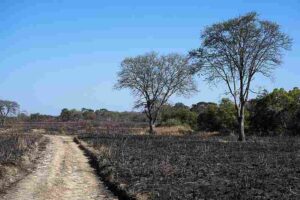
Changes in land use patterns can affect the natural flow of water in the savanna, potentially leading to increased runoff, altered wetland dynamics, and water quality challenges.
In some cases, land conversion can displace or affect indigenous communities that rely on the savanna for their livelihoods and cultural practices, thereby leading to social and economic disruptions. The appeal of the savanna for ecotourism, wildlife viewing, and cultural heritage is diminished as natural landscapes are replaced by agricultural fields.
While agriculture is essential for food production and livelihoods, unsustainable land conversion practices can compromise the long-term food security of local communities.
Additional Notes and Reiterations
When land conversion for agriculture occurs in the savanna biome, the following consequences are observed;
1. Loss of natural habitats and biodiversity.
2. Disruption of ecosystem services and functions.
3. Soil degradation and reduced agricultural productivity.
4. Release of biogenic carbon emissions.
5. Changes in water flow and water quality.
6. Social and economic impacts on indigenous communities.
7. Diminished cultural and ecotourism value.
8. Potential implications for food security and livelihoods.
It is important to implement sustainable agricultural practices, conservation measures, and land-use planning in order to minimize the negative effects of land conversion on the savanna ecosystem, while addressing the needs of human populations.
7). Climate Change: One of the Threats to the Savanna Biome
Climate change is one of the threats to the savanna biome, because it impacts grassland ecosystems in various ways. The effects of climate change on the savanna ecosystem are complex and multifaceted, and may lead to shifts in vegetation, altered rainfall patterns, increased temperatures, and other ecological changes. Some of the key effects are discussed below;
Effects of Climate Change On the Savanna Ecosystem
Effects of climate change on the savanna ecosystem include; increased desertification, altered precipitation trends, temperature rise, shifts in plant and animal behavior, increased frequency and intensity of extreme events, vegetation changes, impact on local communities, and changes in carbon storage capacity.
Climate change can exacerbate desertification in savannas through prolonged droughts, vegetation loss, and increased erosion. Reduced rainfall and extensive dry seasons can transform grasslands into arid landscapes, threatening the livelihoods of both wildlife and human populations.
Changes in climate can lead to shifts in rainfall patterns in savannas. In some cases this can result in more intense rainfall events, leading to water-induced erosion and loss of fertile topsoil. Conversely, longer dry spells can stress vegetation and wildlife.
Rising temperatures which are associated with climate change, can have detrimental effects on the savanna biome. Elevated temperatures can lead to heat stress in both flora and fauna, potentially fostering shifts in species composition and distribution.
Climate change can influence the timing of biological processes/phenomena like flowering, fruiting, and animal migrations in the savanna. These shifts can disrupt ecological relationships and may have cascading effects on species throughout the food chain.
More frequent and intense extreme weather events, such as droughts and heatwave-induced wildfires, are linked to climate change. These events can lead to vegetation loss, soil degradation, and habitat destruction.
Changes in temperature and rainfall patterns can result in shifts in the composition and structure of vegetation in the savanna. For example, increased aridity may favor the expansion of woody plants at the expense of herbaceous grasses.
Climate change can affect the livelihoods of communities that depend on savanna resources. Altered rainfall patterns and temperature extremes can impact agricultural practices, food security, and water availability for these communities.
Savannas are generally vital in carbon storage and climate regulation on various scales. Climate change can disrupt these functions, thereby affecting the global carbon balance and contributing to further climate change.
How Savannas Have Changed Over the Years
Savannas have undergone significant changes over the years, influenced by factors such as land use, climate, and human activities. Some notable changes in savanna ecosystems include; altered grazing patterns, woody weed encroachment, shifts in tree-grass dynamics, deforestation, climate-induced changes, human land use, and fire regimes.
1. The introduction of livestock, such as sheep, goats, and cattle, has had a profound impact on savannas. Overgrazing and changes in pasture composition have altered the vegetation structure.
2. Grazing and land use changes have contributed to the encroachment of woody plants in savannas. This change in vegetation composition usually has ecological consequences.
3. Tree-grass dynamics in savannas have been influenced by factors like land conversion for agriculture, fire regimes, and climate variability. These dynamics affect the balance between trees and grasses.
4. In some regions, savannas have experienced deforestation due to land conversion for agriculture, leading to the loss of natural vegetation.
5. Changes in temperature and rainfall patterns associated with climate change have influenced the distribution and abundance of plant and animal species within the savanna biome.
6. Urbanization, land conversion, and agriculture have transformed savanna landscapes, impacting both natural habitats and local communities.
7. Changes in fire regimes, influenced by land management practices, have affected savanna ecosystems and vegetation structure.
It is important to address climate change, implement sustainable land use practices, and engage in conservation efforts in order to mitigate the effects of climate change on savannas and ensure the long-term vitality and resilience of these unique ecosystems.
Conclusion
Threats to the savanna biome are;
1. Drought
2. Overgrazing
3. Introduction of Invasive Species
4. Urbanization
5. Poaching
6. Land Conversion for Agriculture
7. Climate Change
